What To Look For When Buying A Garden Parasol?

With the arrival of sunny days, a garden parasol becomes an essential accessory for anyone looking to create a comfortable and shaded outdoor space. Whether you're aiming to enhance your garden’s aesthetic or provide ample shade for lounging and dining, choosing the right garden parasol involves more than just picking a colour you like.
Browsing for parasol can quickly become overwhelming, there are so many options. Do you need a cantilever parasol or do you need a table parasol?
Here’s a comprehensive guide to help you make an informed decision when purchasing a garden parasol.
Size and Coverage
Determine the Right Size
The first step in selecting a garden parasol is determining the size you need. Consider the area you want to shade and your garden furniture. The most popular choices for furniture are square corner sets or three seat sofa sets, these larger garden furniture sets need a 3m parasol to provide enough shade. We recommend that you measure the space you want to shade, once you have a rough footprint this will help you determine the right size for your parasol.
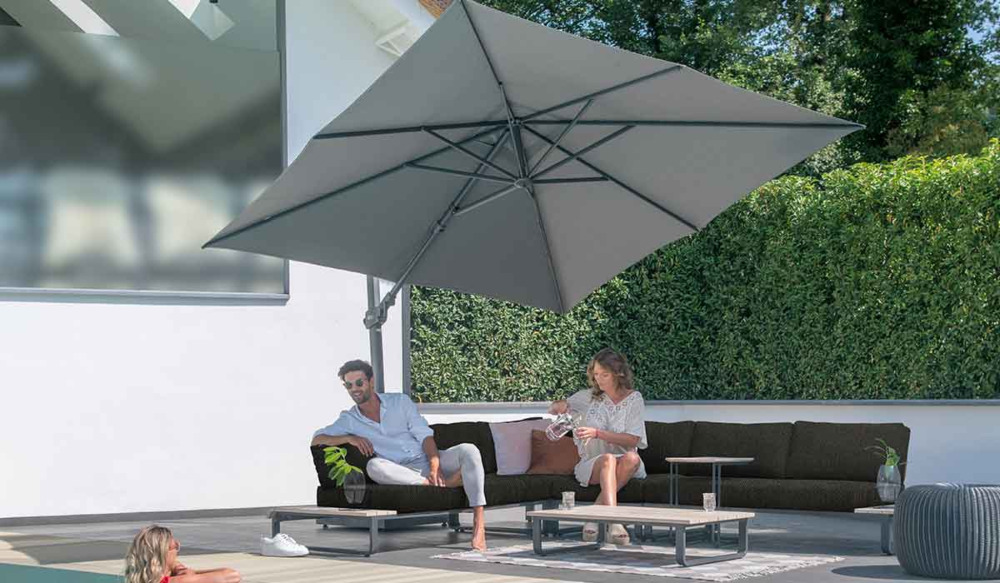
Shape Matters
Parasols come in various shapes such as round, square, and rectangular. Many of our customers want the shape to complement the layout of their garden. Similarly, when speaking to customers, they want the parasol shape to match the shape of their garden furniture. For example, rectangular parasols are ideal for longer dining tables, while round parasols are perfect for smaller, circular tables.
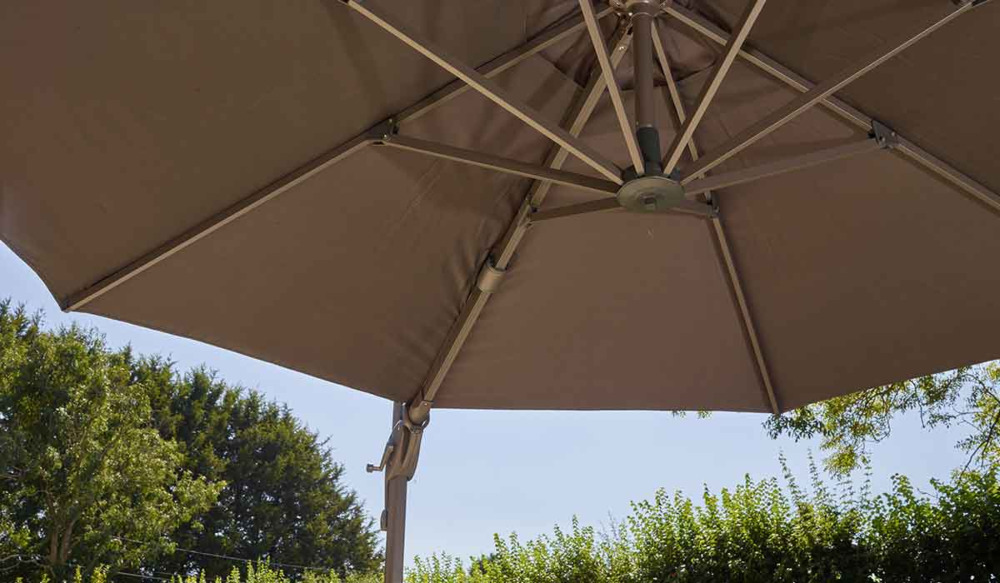
Coverage
The main job of a parasol is to provide coverage, simple as that. Therefore it is important to know what size and shape provides the most coverage. We know it goes without saying but the bigger the parasol the more shade it will provide. So of course a 3.5m parasol provides more coverage than a 3m parasol.
However, the key thing to remember is that shape is important. If you want ample shade we recommend that you go with a square parasol rather than a round parasol. The square shape provides plenty more shade than its round counterpart.
Material Quality
The choice of material can make a big difference to a parasol's overall look and durability.
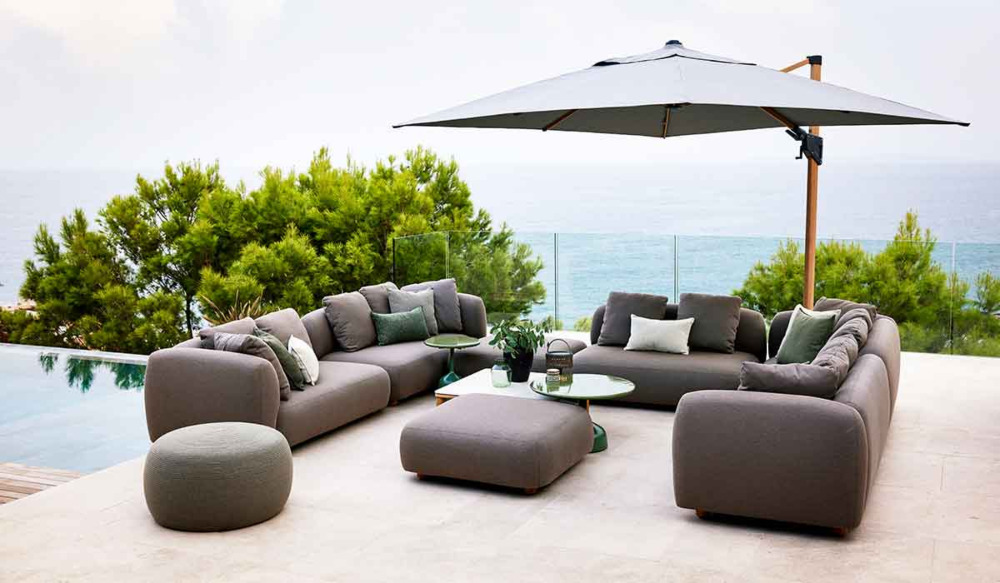
Frame Material
The parasol pole can be made of a number of materials such as:
● Aluminium - Lightweight and rust-resistant
● Wood - Provides a classic look but requires regular maintenance
● Steel - Strong and durable, but can be prone to rust if not properly treated
● Heat Transfer - Provides the look of wood but is made from aluminium
Canopy Fabric
Good quality fabric is crucial for durability and protection from the sun. Look for materials that mention characteristics such as:
● UV-resistant - Protects you from harmful UV rays and prevents the fabric from fading.
● Water-resistant - Ensures the parasol can withstand occasional rain showers.
● Colourfastness - Maintains the vibrant colour over time despite sun exposure.
Popular fabric choices include polyester, Solefin, and Spuncrylic. The difference between the materials are things such as UPF value and colour resistance. For example, Solefin has a higher UPF value and is more colourfast.
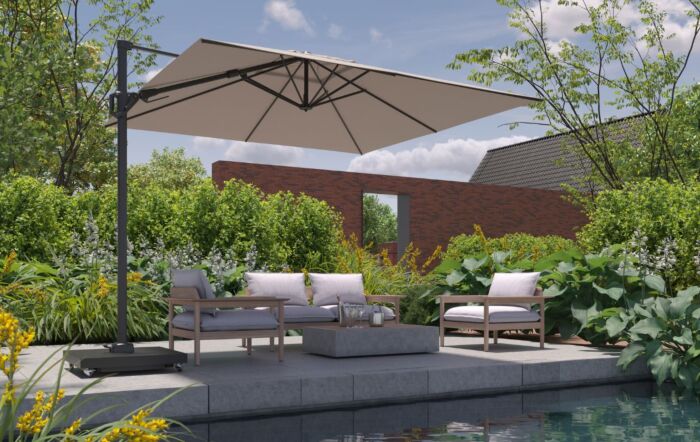
The most common material is polyester as it is durable and has good colour fastness and UV protection yet doesn’t come at a higher cost like Solefin. If you’re looking for a more premium polyester fabric look out for the phrase solution dyed polyester. This means that the fabric is 100% solution dyed and the colour permeates the entire fabric. Solution-dyed polyester canopies have superior colourfastness and weather resistance.
UPF Rating
You’ve probably seen the phrase UPF rating when browsing for a parasol and you might be wondering what it means. UPF stands for Ultraviolet Protection Factor - it is the counterpart of SPF which is used in suncream.
The rating indicates how much UV radiation the fabric blocks out, the highest possible rating for parasols is UPF50+. The ratings used are as follows:
● UPF 40 to 50+ Excellent protection (99+% to 97.5% UV-resistant)
● UPF 25 to 35 Good protection (97.5% to 95.9% UV-resistant)
● UPF 15 to 20 Reasonable protection (94% to 93.75% UV-resistant)
Look for a parasol with a UPF rating of 35 - 50 as this indicates that the fabric is of good quality. All of our parasols have a rating of 35 or above.
Mechanism and Ease of Use
Parasols should be easily manoeuvrable and have simple mechanisms. There are so many options out there and different functionalities. Some cantilever parasols can tilt and rotate whereas others can do all that and light up.
Opening and Closing
Consider how easy it is to open and close the parasol and which mechanism you would prefer. Common mechanisms include:
● Crank Handle - Easy to operate, used for cantilever parasols
● Pulley System - Traditional and straightforward but may require more effort
● Push-Up Mechanism - Simple manual push up used in table parasols
In recent years more high quality parasols have moved away from the traditional pulley system. Although it is easy to do as you just pull the string it does require more effort and strength to open the parasol.
Cantilever parasols tend to open using a handle which you can wind clockwise to open the parasol - couldn't be any simpler. If you would like to know more on how to use a cantilever parasol read our guide.
Tilt and Rotation
Parasols with tilt and rotation features allow you to adjust the angle of the canopy to block the sun throughout the day. These features are more common in side post parasols. However, some table parasols do offer a tilting mechanism but do not rotate. If you’re looking for more flexibility we would recommend looking at cantilever parasols.
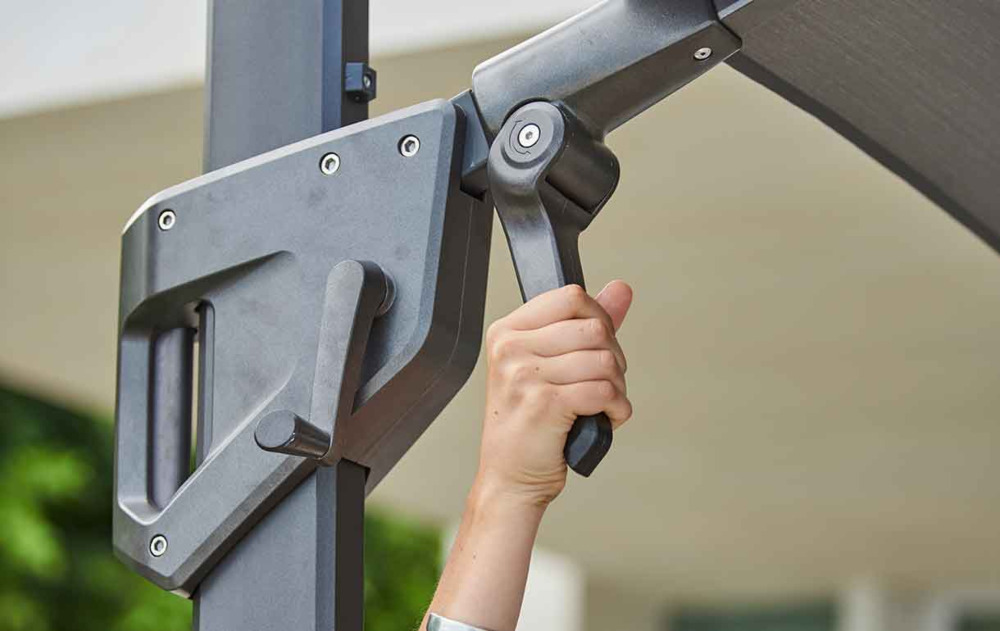
As shown in the above image you will find a large handle which can be used to tilt a parasol. The handle will either pull towards you or push towards the canopy. This feature allows you to tilt the parasol left and right offering more flexibility and protection against the sun.
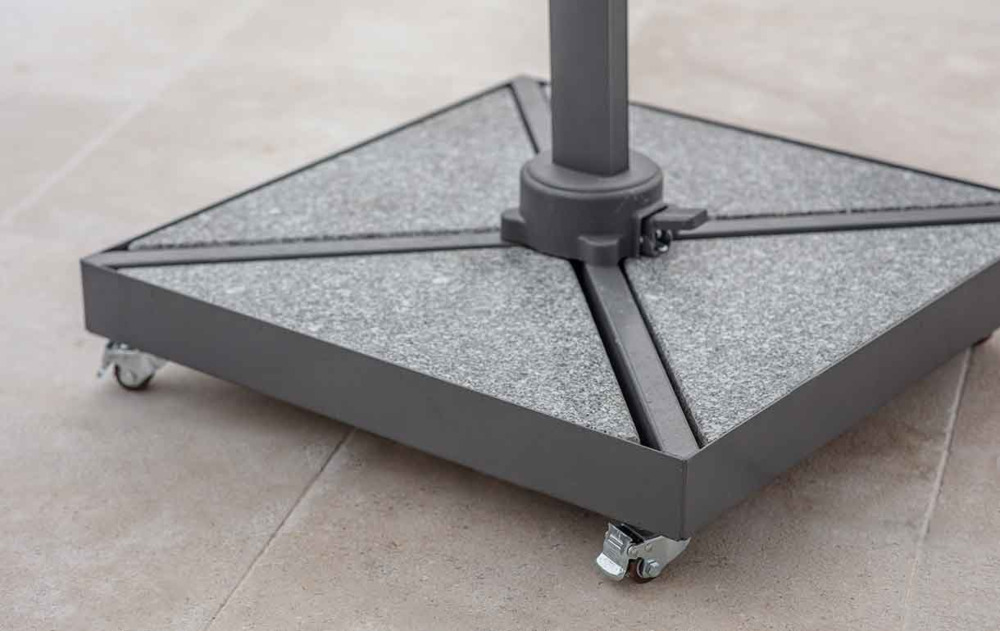
If you’re looking for a parasol to rotate look out for pedals on the base as seen in the image above. These are straightforward to use, just step on the pedal and the pole will rotate 360 degrees.
Both of these features give you more freedom in your garden, they enable you to effortlessly move your parasol as the day progresses. When speaking to our customers this sort of flexibility is something they look for in cantilever parasols.
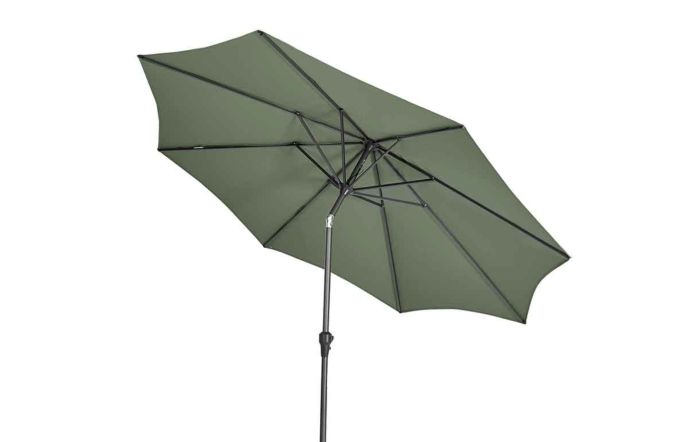
However, if you have a smaller space or want to get a parasol to sit within a table some models out there do tilt. You’ll find towards the top of the pole they have a mechanism you can push which allows you to tilt the canopy.
Light Up Parasol
Now if you’re looking for a parasol with the wow factor you need to look at a parasol with LED lights. Perfect for adding a relaxing ambience to your garden. Some models feature lights only on the parasol spokes whereas others will have lights on the spokes and the centre of the parasol. The choice of lighting model is entirely a matter of personal preference.
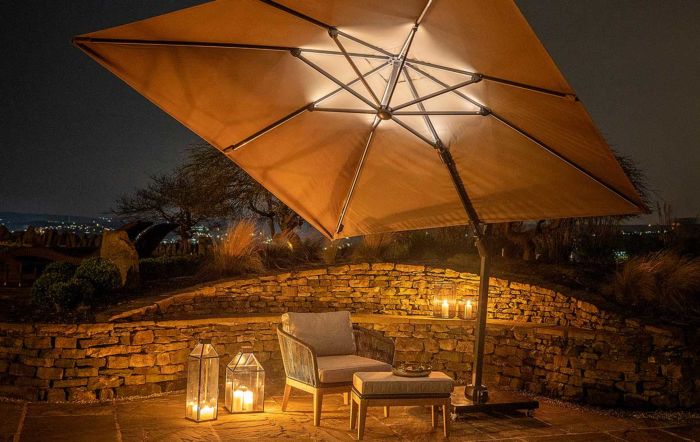
To operate the lights you will find a battery pack attached to either the parasol pole or the parasol spoke. The pack is detachable so you can recharge the batteries indoors.
Choosing the right base
The final piece of the puzzle is the parasol base, this seemingly simple element is crucial to keeping your parasol stable. The base you choose depends on whether you go for a cantilever or a centre pole parasol. Similarly, it is important to consider if you will want to move the parasol around your garden as some bases weigh up to 125kg! If that’s the case then we would encourage you to look at a base on wheels.
When choosing a base there are several choices, some parasols only take a particular base so if you’re unsure please reach out. The most popular choice is a granite base - this is thanks to its aesthetic qualities and durability.
Granite Base
A solid base is essential for keeping your parasol stable, especially in windy conditions. Ensure the base is heavy enough to support the size of your parasol. If you go for a 3m side post parasol we would advise you go for a granite base weighing at least 90kg.
Granite bases are a suitable choice for table parasols too, perfect for keeping your parasol safe and secure.
If you’re looking for more manoeuvrability and flexibility then we advise you to look at granite bases with wheels. Wheeled granite bases allow you to move the parasol around your outdoor area with ease.
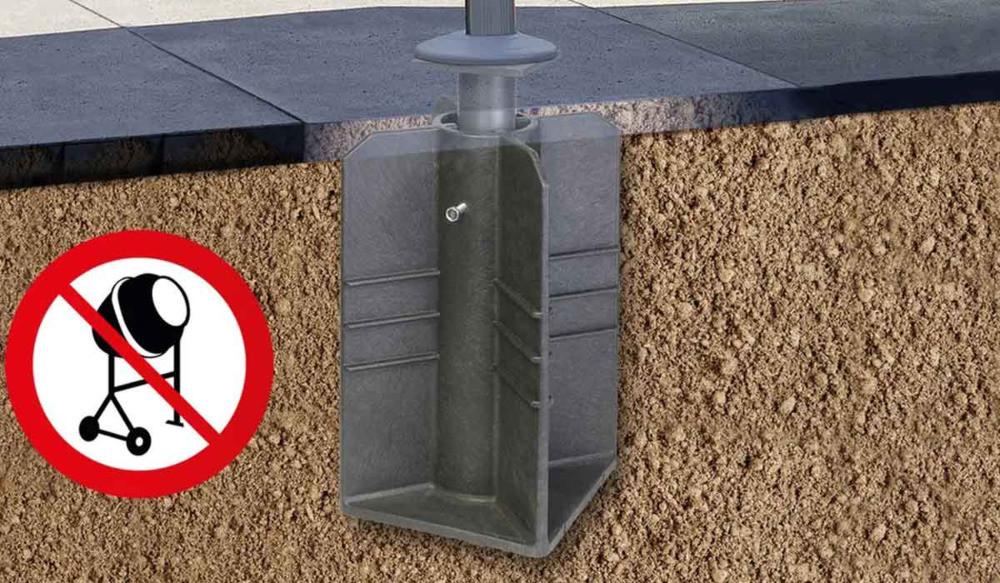
In Ground Base
In-ground bases are an innovative space saving solution however they are only suitable for cantilever parasols. They’re easy to dig in and you don’t need to pour concrete. They are suitable for parasols sized 3m, 3.5m and 3.5m x 2.6m.
Water/Sand Fill Base
One popular choice is a base you can fill with water or sand. These bases are a popular choice as before you fill the base you can easily move the parasol into position. Similarly if you need to move the base it is easy to empty the base and then relocate the parasol.
Concrete Base
Another great choice is concrete, like granite, concrete bases are sturdy and durable. However, granite is more popular because of its stylish and classy appearance. Concrete bases can be called concrete fill bases what this means is that it has a resin or plastic casing and the concrete is then poured into the base. This protects the concrete from chipping and damage.
What about the wind?
Many of our customers will ask us how a parasol fares in the wind. We would always advise you never to use parasols in high winds. If you live in an area prone to wind we would recommend going for a cantilever parasol rather than a table parasol. The design of a cantilever parasol means that during windy conditions the parasol will wobble to counteract the wind. Thus preventing the parasol from falling over.
Style and Aesthetics
Once you have figured out your needs then style can come into it. Before thinking about aesthetics it is important to know what you need from your parasol.
We know that colour choice can make a big difference to the overall look and feel of your garden area so it is a good idea to consider what look to achieve.
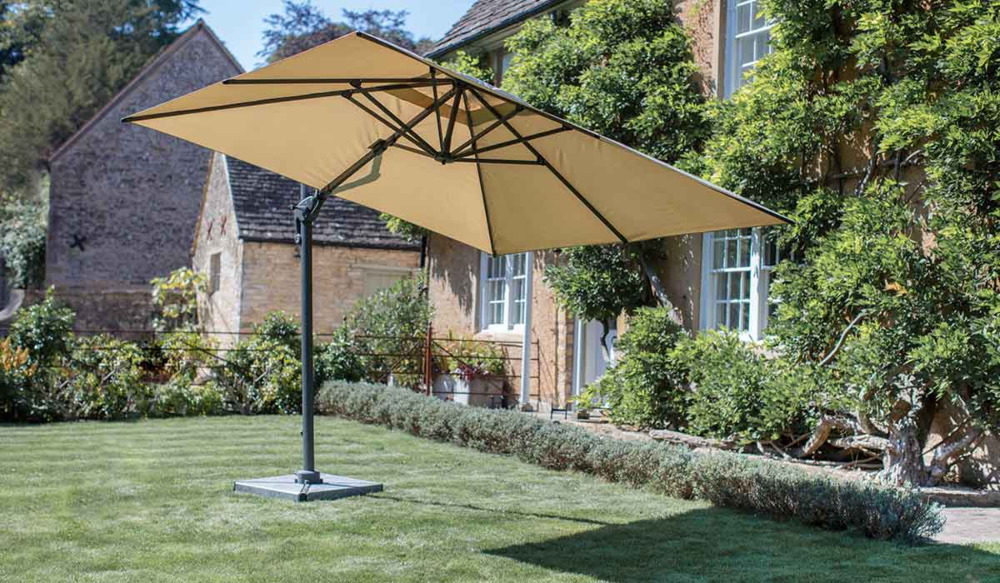
Choose a colour that complements your outdoor decor. Neutral tones like sand and grey are versatile, while bold colours can make a statement. Many of our customers like to match the canopy to features in their garden such as existing furniture, patio tiles and even the brick on their house. Choosing a complementary colour allows you to have a more cohesive look.
Budget and Warranty
Price is always a key factor when choosing any furniture, indoor or outdoor. Outdoor parasols come in a wide range of prices. For example, table parasols can be lower priced due to their functionality and size. Whereas a 3m LED cantilever parasol can be on the higher end when it comes to cost.
Think about the features you need and consider if they will need a higher budget. Investing in a high-quality parasol may cost more upfront but can save you money in the long run due to its durability and longevity.
Warranty
One thing that is important to people when purchasing garden parasols is a warranty. Warranties show that the manufacturer has faith in their product. All of our parasols come with a manufacturer warranty of at least one year. If any issues do arise we are always on hand to help.
Selecting the perfect garden parasol involves considering size, material, ease of use, style, and budget. By evaluating these factors, you can choose a parasol that not only enhances your outdoor living space but also provides reliable protection from UV rays for years to come. Happy shopping!
--------------------
Have further questions about how to use your parasol? Our friendly, knowledgeable team are always on hand to help, just give us a call or visit one of our showrooms in Wakefield or Newcastle.
About the Author

Dave Sadler is a garden parasol expert with a passion for outdoor elegance and functional design. With years of experience in the garden furniture and parasol industry, he’s become a go-to expert on all things parasols - from choosing the perfect shade solution to seasonal styling tips.

















